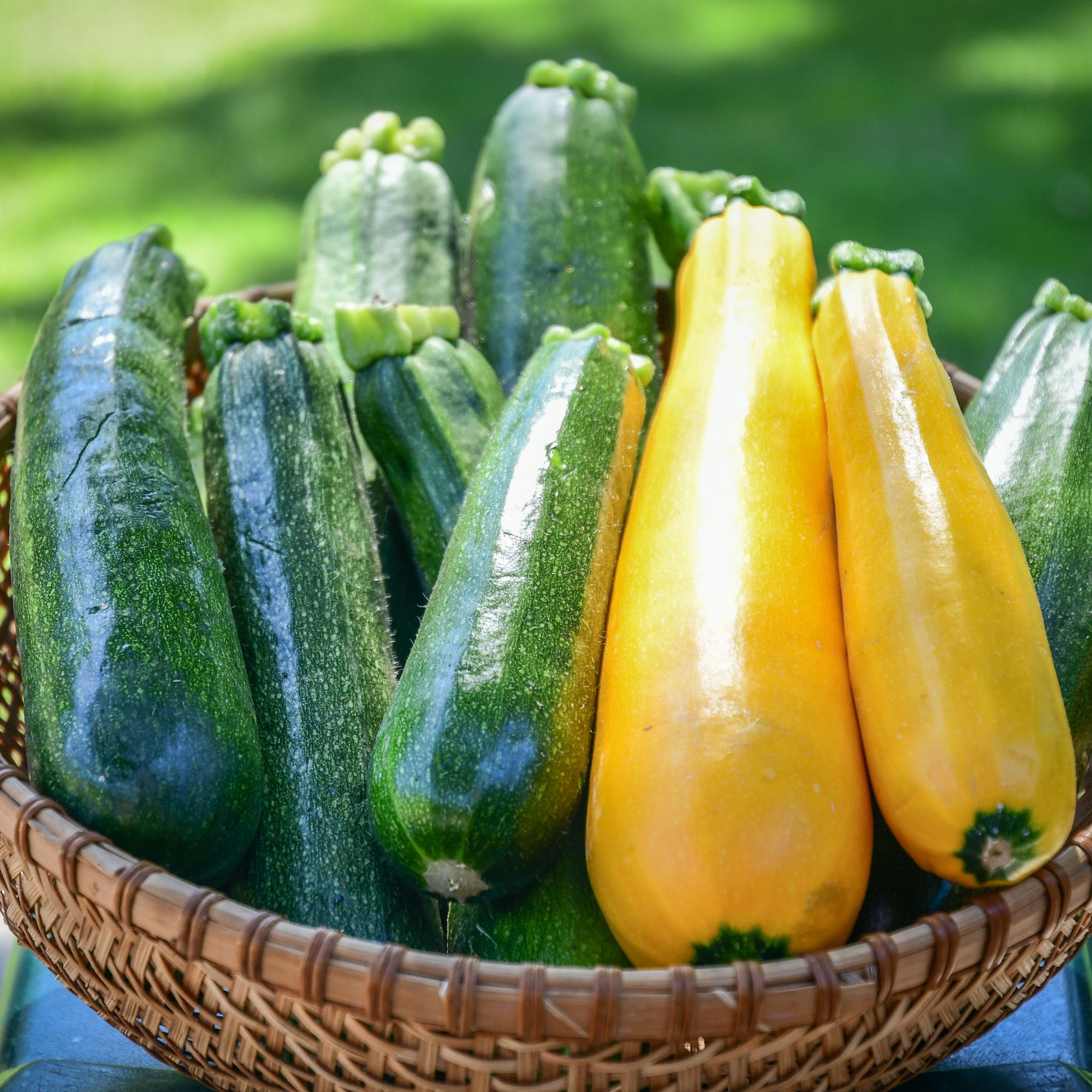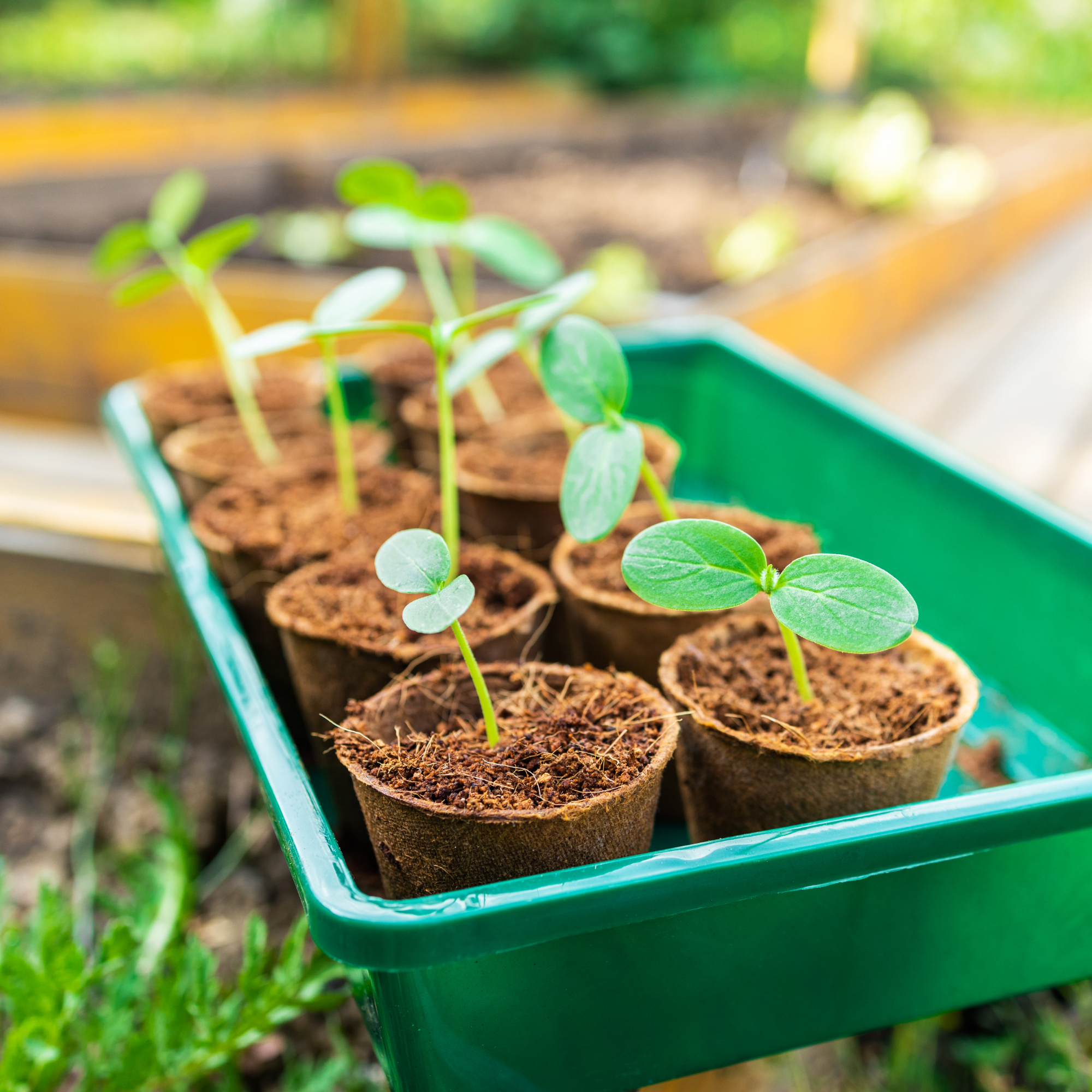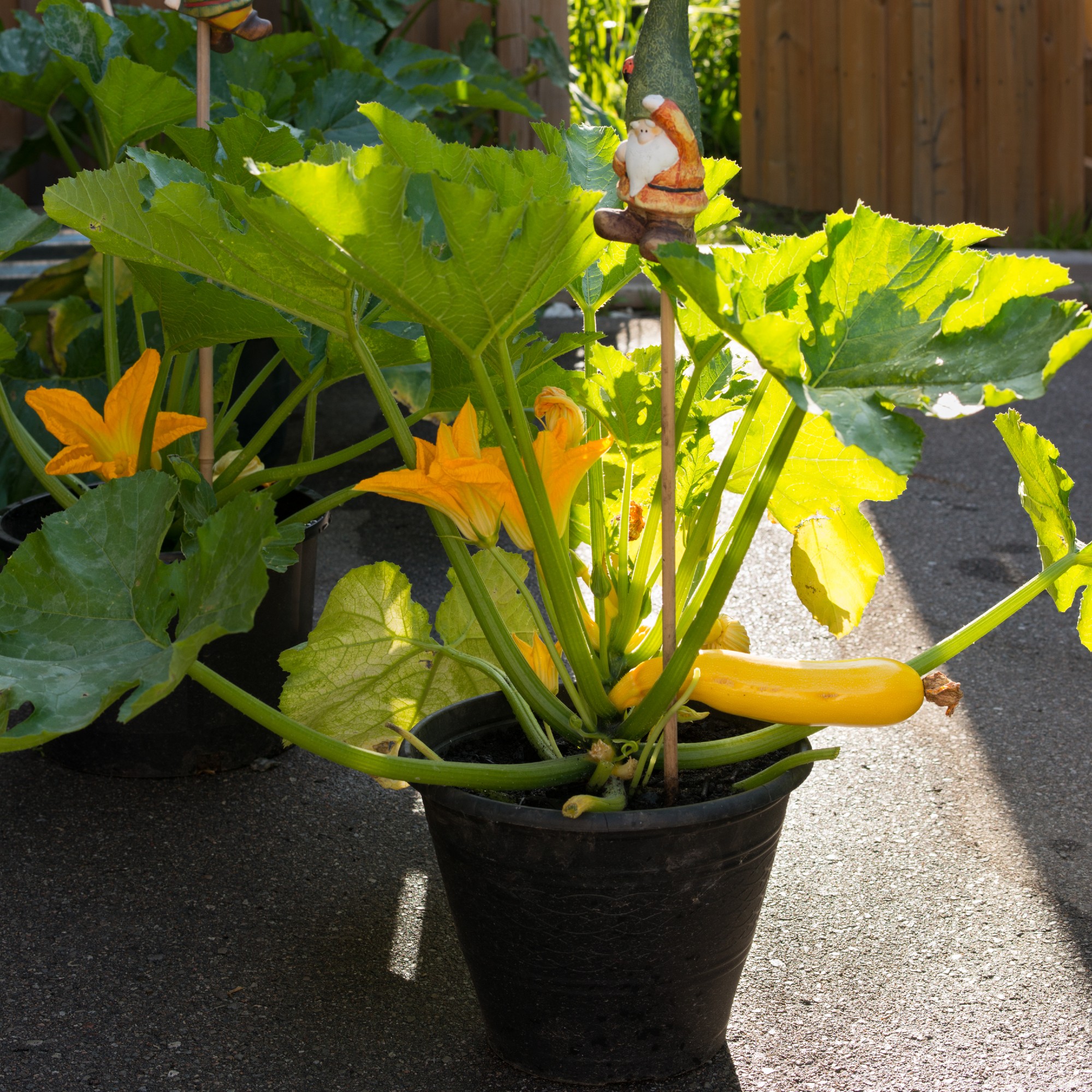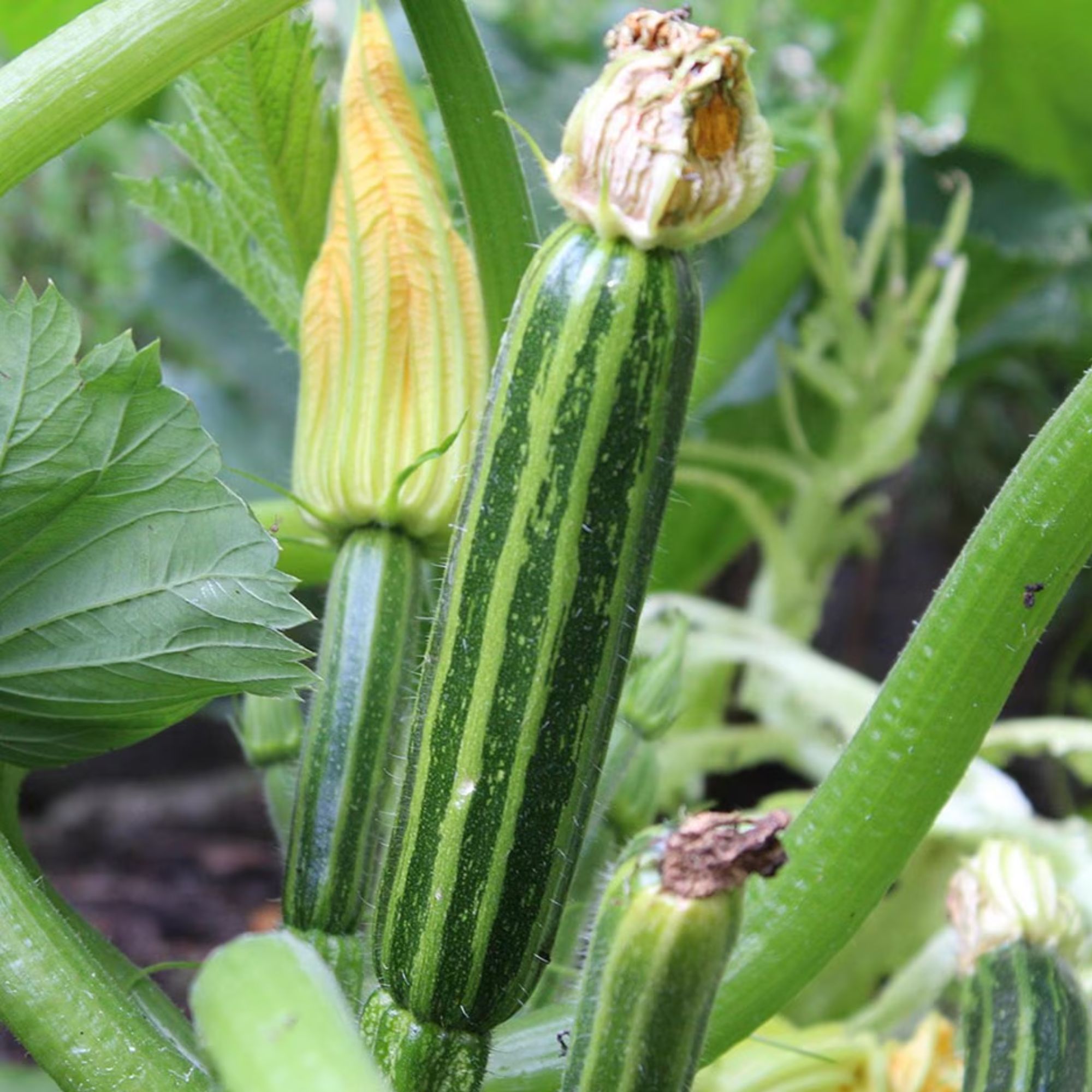
While I can’t imagine a summer without growing courgettes, at a metre wide, this is a plant that seriously needs its space. Plus, beware the glut and lurking marrow.
They are one of the easiest vegetables to grow for beginners, but wow – courgettes are real garden-hoggers. Umbrella-like leaves mean prolific and delicious sausage-sized fruits can be hidden from view, only to turn into gigantic marrows – and that, friends, is not a Cinderella story.
Thankfully, there’s a simple solution – send them skywards.
Growing vegetables vertically doesn’t just save space. It improves airflow, makes picking easier and means you’ll never again have an overflowing marrow harvest to press upon your neighbours. Whether you’re looking for small space garden plot ideas or are the proud custodian of an allotment, here’s how to grow courgettes vertically– and why you’ll never look back.
Why grow courgettes vertically?
Courgettes have a reputation for taking up a lot of room, but with a little support, they can easily be trained to grow upwards rather than outwards.
‘Courgettes usually flop and drape themselves across every poor vegetable surrounding them,’ says August Bernstein, Head Tutor at the Raymond Blanc Gardening School.
‘But if you grow them vertically, you keep the bed clear and make space for your other veg to flourish.’
Growing vertically also helps prevent common courgette problems – and this is one I’ve experienced a lot on my allotment. ‘Courgette fruits often develop blossom end rot,’ explains Annelise Brilli, horticultural expert at Thompson & Morgan. ‘Growing them vertically improves airflow and minimises this problem.’
Plus, upright plants are easier to check and pick. ‘The fruits can often hide beneath leaves and become huge,’ adds Annelise. ‘But by training them vertically, they’re easier to spot – plus you won’t get scratched by the hairy leaves and stems.’

What you'll need
Step-by-step
1. Choose the right variety

Not all courgettes are natural climbers, so variety matters. ‘If you’re giving vertical growing a go, make sure you find a variety suited to it,’ advises August. ‘'Shooting Star' is a great one to try – it has stunning yellow fruit and grows up to 1.2m tall.’
Annelise also recommends ‘Black Forest’, a climbing courgette that’s ideal for vertical growing. ‘It’ll produce high yields – just tie its long stems onto trellis, netting or a sturdy wigwam of canes and keep on picking.’
And if you fancy something a little different? Lucy Hutchings, gardening expert and co-founder of She Grows Veg, suggests thinking outside the (courgette) box.
‘Courgettes aren’t naturally climbing plants,’ she explains. ‘Another approach is to grow multipurpose squash like Tromboncino, Pineapple or Kamo Kamo. They climb brilliantly and can be eaten like courgettes when young – or left to mature into winter squash.’

2. Sow your courgette seeds
Once you’ve picked your variety, it’s time to sow your seeds. Make sure you know when to plant courgettes – typically from late April to early June – and brush up on how to sow seeds if you’re just starting out.
Courgette seeds are large and easy to handle, making them ideal for beginners. Sow one seed per small pot, about 2cm deep, and keep them warm and moist. A sunny windowsill or heated propagator works well to get them going. In around 7-10 days, you should see the first green shoots appear.
If you’ve got a greenhouse or warm conservatory, you can start them off even earlier to get a head start on the season.

3. Choose the right position
While your seedlings are getting established, use the time to prepare the best home for them outdoors. Courgettes are sun-worshippers and need at least 6-8 hours of sunlight a day, so choose a warm, sheltered spot with fertile, free-draining soil.
‘They grow quickly and get heavy,’ explains August, ‘so I usually plant them at the back of my beds next to a fence and train them up a trellis.’
Courgettes are hungry plants, so it’s worth digging in plenty of compost or well-rotted manure before planting. If your soil is heavy or slow to drain, consider building a small mound or planting into raised beds to avoid soggy roots.
However, they do need a lot of water, so be sure you’ve got good access to the base of the plant. I tend to bury a length of pipe next to the roots as a watering tube, and it works a treat.

4. Support your plants properly
So you’ve sown your seeds, you’ve got your site ready, it’s time to plant. Strong support is key, especially once the fruits start forming. Do not underestimate this; I can’t state that strongly enough!
‘Use a trellis, a sturdy wigwam of canes, or grow up a fence,’ suggests August. ‘Just make sure it’s robust, as courgettes can get heavy.’
Josh White, Nursery Manager at Roots Plants, agrees. ‘Regularly tie the main stem into the support using twine,’ he advises. ‘Stakes tend to work better than bamboo as they’re sturdier – it helps keep the plant upright and the fruit off the ground.’
If you’ve got the space, Lucy suggests going architectural. ‘Growing over arches looks stunning and makes harvesting easy,’ she says. ‘It’s a great way to use the space over pathways and dramatically reduces the footprint of large, rambling plants.’
Shop plant support picks
5. Water, feed and prune for better yields
Once your courgette is climbing, it’s all about maintenance. Like most fruiting veg, they’re hungry and thirsty, especially in warm weather.
‘Keep the plant well watered and to boost your harvest, try hand pollinating with a feather or small brush – dust the male flower’s pollen onto the female one.’ Need a reminder of which is which? ‘The female flower has a mini courgette forming behind it,’ she explains. ‘If you only see male flowers, don’t panic – the female is on its way.’
I also feed once a week with a general-purpose tomato feed once you’ve spotted the first fruit. It tops up the plant’s nutrients while it’s in peak production mode, leading to better and more courgettes.
Plus, ever wondered how to get rid of powdery mildew on courgette plants? August recommends simply removing the affected leaves. ‘This will stop it spreading,’ she explains.
When it comes to harvesting, you need to get in there quickly – pick the fruits while they’re young. ‘The bigger they get, the more watery the flavour – and you’ll have more than enough from just one plant to feed a family of four all summer,’ August adds.
A cheat sheet for growing courgettes vertically
- Use strong supports – flimsy bamboo canes won’t cut it once the fruits grow.
- Tie in regularly – keep the main stem trained upwards as the plant grows.
- Feed weekly – a tomato fertiliser works well once fruits start forming.
- Watch for mildew – trim affected leaves and water at the base, not overhead.
- Pick little and often – harvesting regularly encourages more fruit.
Well, there you have it. That’s everything you need to know about growing courgettes vertically! Will you be giving it a go?







